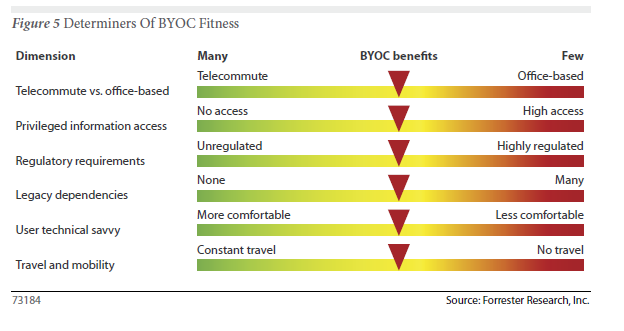Bring your own device movement by the numbers

Bring your own device schemes in corporations---a movement that's coming whether tech execs like it or not---has resulted in a lot of underground IT.
This underground IT movement was highlighted in a Forrester Research report on bring your own device (BYOD) programs.
The set-up:
Like the few drops of rain and a fresh breeze that foreshadow a coming storm, the latest round of bring-your-own-computer (BYOC) demand started in your company with a few Macs showing up in meetings, Windows 7 appearing in scans of computers on the network, and a handful of tickets to the help desk for configuring email and network access. Steadily, the rain increased as co-workers saw them and wanted to do the same — and a flood of demand now threatens to breach the levees. It’s not a question of how to stop the rain but rather of how to channel the flow and harness the river to power the town.
But we knew that already. In fact, much of the Forrester report is known to some degree. The punch line is that IT execs need to use virtualization and other tools to harness BYOD.
Related: Great Debate: Bring your own device | MS Office vs. Quickoffice: BYOD could win the battle | Attention CXOs: There's something you need before you BYOD. | BYOD: What the people think | Apple's enterprise strategy: Steady as consumerization goes
Forrester's report, however, did feature a few interesting data nuggets. Here's a look at BYOD by the numbers:
- $1,253: Average amount spent a year by workers on their own gear for doing their jobs.
- 74 percent: Percentage of individual workers that paid entirely for their work laptop.
- 12 percent: Portion of companies that encourage employees to bring their own devices.
- $3,917: Average amount an executive or president has spent on his own work computer over the past 12 months.
- 50 percent: Portion of companies still using Windows XP on corporate desktops and laptops.
Forrester said in its report that BYOD programs need to be evaluated by worker type. This graphic sums up the costs and benefits.
